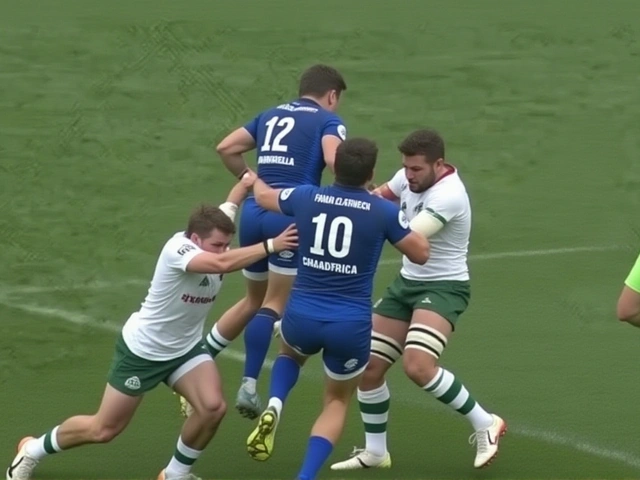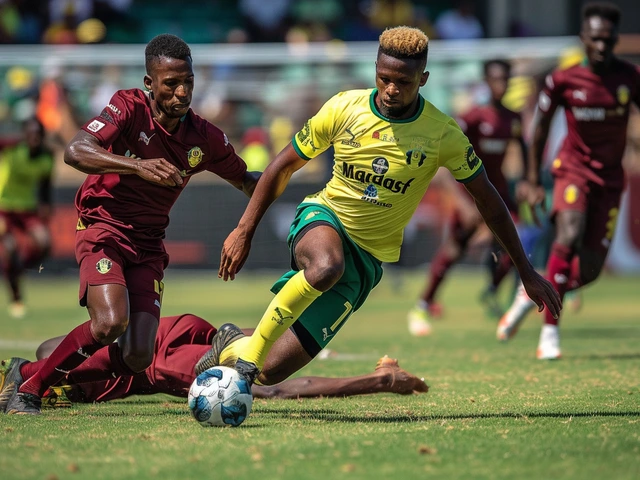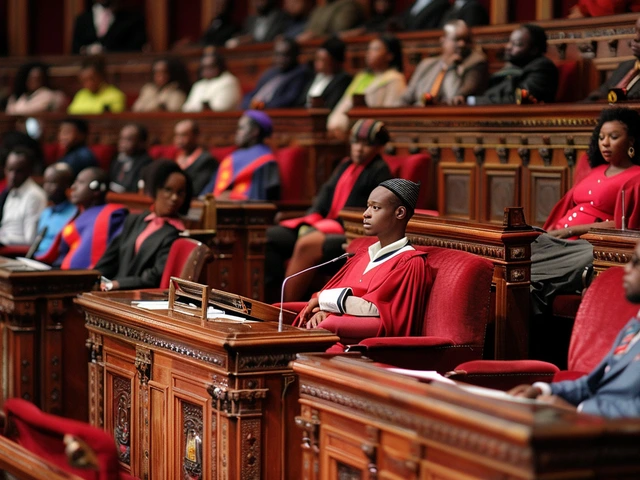
When Franco Mostert dropped to his knees to tackle Italy’s Paolo Garbisi during South Africa’s 32-14 win in Turin on November 15, 2025, he thought he was doing everything right. He was wrong — until he wasn’t. A red card, issued under Law 9.13 for dangerous contact, sent shockwaves through the Springbok camp. But just three days later, the World Rugby Disciplinary Committee reversed course, downgrading the card to yellow and clearing Mostert to play this weekend. The twist? The committee found something the match officials missed: daylight.
What the Committee Saw That Referees Missed
The World Rugby Disciplinary Committee, chaired by Stephen Hardy of Australia and joined by former internationals Ofisa Tonu'u and Jamie Corsi, spent hours reviewing every camera angle, slow-motion replay, and biomechanical analysis. They confirmed head contact occurred — but not how it happened. Mostert’s initial point of contact was Garbisi’s shoulder. Not the head. Not the neck. The shoulder. And there was a clear gap — what officials called ‘daylight’ — between that shoulder hit and the Italian flyhalf’s head.
Head contact, the committee concluded, was secondary, low-force, and not reckless. Under World Rugby’s head contact process, a red card requires a clear, dangerous, high-impact collision with the head or neck. This didn’t meet that bar. The decision wasn’t just a technicality — it was a correction. Mostert’s red card was expunged from his record. He’s eligible to face Wales on Saturday.
The Bigger Problem: Inconsistent Calls
This isn’t just about Mostert. It’s about the chaos in the tackle zone.
Just seven days earlier, Lood de Jager, the 2.06-meter Springbok lock, was handed a red card for a tackle on France’s Thomas Ramos in Paris. De Jager was on one knee. Ramos was on his knees too. The contact? Shoulder to shoulder, with incidental head bump. Yet, De Jager got a red. Then a four-match ban. His appeal hearing is set for November 19, but sources say even a reduced suspension would be a win.
Coach Rassie Erasmus didn’t hold back. ‘We don’t know how to coach guys any different,’ he said. ‘For a two-metre tall guy and a 2.06-metre guy to go lower than a guy on his knees — it’s tough.’
And he’s not wrong. Earlier in the tour, Siya Kolisi and Marco van Staden were both struck with shoulder-to-face contact that looked far more dangerous than Mostert’s or De Jager’s. No cards. No reviews. Just silence.
The Coaching Dilemma
Springbok head of athletic performance Andy Edwards has spent the last two years running specialized mobility drills — hip flexor work, back strength, low-center-of-gravity drills — to help giants like Mostert and De Jager get lower without breaking their spines. They’ve trained for this. They’ve sacrificed their bodies for this. And now, they’re being punished for trying.
‘We’re being asked to bend like bamboo in a hurricane,’ one assistant coach told reporters off the record. ‘If you go low and you’re tall, you’re a target. If you stay upright, you’re a criminal. There’s no middle ground.’
World Rugby’s ‘lower tackle’ mandate, introduced after the 2023 World Cup, was meant to reduce head injuries. But it’s created a new kind of danger: the danger of confusion. Players don’t know what’s legal anymore. Coaches can’t give clear instructions. Referees are playing a game of guesswork.
A Rare Win for Reason
The overturn of Mostert’s red card is rare. Bunker reviews rarely get reversed. But when they do, it’s usually because the evidence is overwhelming. In this case, it was. The committee didn’t ignore the rules — they applied them correctly.
This decision sends a message: not every head contact is a red card. Not every tackle from a tall player is dangerous. Context matters. Intent matters. Force matters.
But it also highlights the system’s fragility. One decision saves Mostert. Another could end De Jager’s tour. And the players? They’re caught in the middle.
What’s Next?
De Jager’s appeal on November 19 will be the real test. Will the committee apply the same logic? Or will consistency remain a myth?
World Rugby has promised a review of its head contact protocol by December. But for now, the message to teams is mixed: ‘Go low’ — but don’t go too low. ‘Protect the head’ — but don’t get punished for doing it right.
Meanwhile, Mostert is back on the field. He’ll play Saturday. He’ll tackle. He’ll hope the next referee sees what the committee saw: daylight.
Frequently Asked Questions
Why was Franco Mostert’s red card overturned but Lood de Jager’s wasn’t?
The disciplinary committee found Mostert’s contact began with the shoulder and had ‘daylight’ before any head contact, which was minor and non-dangerous. De Jager’s tackle, while also low, had a different trajectory and higher force at the point of head contact, which the committee deemed to meet the red card threshold. The two incidents, though similar in appearance, were judged on distinct biomechanical evidence.
How does this affect Springbok selection for the upcoming matches?
Mostert is now fully available for selection, strengthening South Africa’s second row ahead of their match against Wales. With De Jager still suspended, Mostert’s return is critical — especially as the Springboks prepare for a physically demanding end to their northern hemisphere tour. Coach Erasmus now has two fit locks instead of one.
What is the ‘daylight’ principle in World Rugby’s tackle rules?
‘Daylight’ refers to the visible space between the point of initial contact and the head or neck of the player being tackled. If there’s clear separation — meaning the tackler hits the body first and the head is not the primary target — the incident may not reach the red card threshold, even if incidental head contact occurs. This concept is now central to evaluating high tackles under the updated protocol.
Are tall players being unfairly targeted under current tackle rules?
Many coaches and analysts believe so. Tall locks like Mostert and De Jager have limited mobility to lower their center of gravity quickly. When they do, they often make contact with the upper body of smaller, kneeling opponents — leading to accidental head contact. Critics argue the rules don’t account for physical reality, creating a systemic bias against taller players despite their efforts to comply.
What changes can we expect from World Rugby after this incident?
A formal review of the head contact process is scheduled for December, with pressure mounting to introduce tiered sanctions — such as a ‘warning’ category for borderline incidents — rather than binary red/yellow outcomes. Coaches are also pushing for clearer visual guidelines for referees, possibly including on-field overlays to indicate acceptable tackle zones.
How many red cards have been overturned by the disciplinary committee this year?
This is only the second red card overturn in 2025, and the first involving a lock. The only other was in July, when a New Zealand flanker’s card was reduced after video evidence showed the contact was initiated by the opponent’s shoulder. Such reversals remain extremely rare, making Mostert’s case a landmark moment in the ongoing debate over tackle safety and officiating consistency.






Daylight. Just daylight. That’s all it took. 🙌
This is just the beginning. Wait till you see the leaked memo from World Rugby about how they’re secretly testing AI referees that only like skinny players. They hate tall guys. It’s not about safety - it’s about aesthetics. 🤫
There’s a deeper metaphysical tension here. The tackle is not merely a physical act - it is a negotiation between gravity and grace. When a man of 2.06 meters lowers himself, he does not merely bend his knees - he bows to the gods of sport, hoping they’ll forgive his height. The ‘daylight’ is not a technicality. It is divine intervention. And yet, why does grace only visit the lucky few?
Let’s be real - Mostert got off because he’s a Springbok and De Jager is just a ‘big dumb lock.’ This isn’t about biomechanics, it’s about institutional bias. The committee didn’t ‘see daylight’ - they saw a brand. The same people who gave a yellow to a guy who clipped a winger’s head at 80km/h are now crying over ‘incidental contact.’ Pathetic. You can’t fix a broken system by cherry-picking wins.
I’ve studied every frame. Every millisecond. The shoulder-to-shoulder contact in De Jager’s tackle? It was a 0.3-second window where the head was in the danger zone - statistically significant, biomechanically unavoidable, and therefore reckless. Mostert? His center of mass was lower, his hip flexion angle was optimal, and the angular velocity of his torso was below the 2.7 rad/s threshold for dangerous contact. The committee didn’t just ‘see daylight’ - they applied physics. De Jager’s tackle? Pure negligence. And yet, the rugby world still clings to the myth of ‘consistency.’ There is no consistency - only context. And context is everything. The real tragedy? Players aren’t taught this. Coaches aren’t trained in kinematics. We’re letting athletes gamble with their brains because we refuse to evolve.
This is why I tell my lads: go low, but go smart. Don’t just drop - *engineer* the tackle. Mostert didn’t get lucky. He trained. He’s got the mobility drills, the core stability, the timing. De Jager? He dropped too late, too stiff. It’s not about height - it’s about technique. And if the refs can’t see the difference, then maybe they need to watch film with us, not just with their eyes.
So let me get this straight - you train for years to get lower, sacrifice your knees, your back, your dignity… and the system still punishes you for doing it right? Meanwhile, some 1.80m guy who launches himself like a cannonball gets a pat on the head? 🤦♀️ This isn’t safety. This is sport’s version of ‘I’m not racist, but…’
In Nigeria, we have a saying: ‘When the wind blows, the tall tree bends - but the short bush breaks.’ This isn’t just rugby. It’s culture. The rules were made by men who never had to carry 120kg of muscle on a 2-meter frame. They want you to bend like bamboo - but bamboo doesn’t have hip replacements. The ‘daylight’ isn’t just space between shoulder and head - it’s the space between policy and reality. And right now, that gap is a canyon.
so like… mostert got lucky?? but also not?? like the committee actually looked at the video?? and de jager didnt?? i mean… i get it but also… why is this so confusing?? 😅
The overturn of Mostert’s red card is a testament to the value of meticulous review and the courage to correct error. While the decision is welcome, it underscores a systemic failure: the absence of standardized, transparent criteria for referees on the field. The introduction of real-time biomechanical overlays - calibrated to player height, speed, and tackle angle - would not only reduce inconsistency but also restore trust in the game. Coaches and players deserve clarity, not chaos.